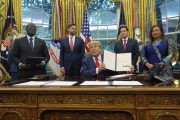
Texas State Representative Bryan Slaton (R) filed the Texas Independence Referendum Act (H.B. 3569), or TEXIT, on Monday, stating that if passed, it would allow voters in the 2024 election to decide “whether or not the State should investigate the possibility of Texas independence, and present potential plans to the Legislature.”
Simply put, if the act passes in the statehouse, and gains Governor Greg Abbott’s signature, Texas voters will vote on the possibility of Texas seceding from the United States. Once passed, the act would require the establishment of a joint interim “Texas Independence Committee.” That group would study and recommend to the legislature by December 31, 2024, the “most effective and expeditious method by which Texas may be returned to its status as an independent nation.”
“The Texas Constitution is clear that all political power resides in the people. After decades of continuous abuse of our rights and liberties by the federal government, it is time to let the people of Texas make their voices heard,” Representative Slaton said in his tweeted press release.
Slaton continued, “On this 187th anniversary of the fall of the Alamo I’m proud to file this bill to let the people of Texas vote on the future of our State. Texas was born out of a desire for liberty and self-governance, and that desire continues to burn in the hearts of all Texans.”
Slaton’s bill is getting full support from the Texas Nationalist Movement, a large organization, with over 440,000 members fighting for the independence of Texas. Their website declares: “Our mission is to secure and protect the political, cultural and economic independence of the nation of Texas and to restore and protect a constitutional Republic and the inherent rights of the people of Texas,” and that Texas should be “politically self-governing, culturally distinct, and economically independent.”
What exactly is TEXIT, and what does it mean to supporters? The Texas Nationalist Movement clearly states that “TEXIT is not Texas independence. Rather, TEXIT is the process that gets Texas to independence. TEXIT means that Texans determine our own laws and not 2.5 million unelected bureaucrats in Washington. It means that we get a government that begins and ends at the borders of Texas. It means an end to the giant sucking sound of $103-$160 billion dollars per year being siphoned from the pockets of Texas taxpayers. Most importantly, it means that for the first time in our lives we control our own destiny.”
This is not the first time since the civil war, or more accurately, the war between the states, that secession from the union or even secession from within existing states has been sought. You have several counties in California and Oregon that have long sought to become the state of Jefferson. Recently there has been a movement with rural counties in Oregon seeking to secede and join Idaho as they want to escape the leftist policies of Oregon’s woke leadership.
Currently the momentum for TEXIT is strong among Texas voters. The Washington Examiner reported Texas Nationalist Movement President Daniel Miller said in a statement, “Sixty-six percent of likely voters in Texas support this referendum coming up for a vote, and we thank Rep. Slaton for taking heed and giving them the opportunity to make their voice heard at the ballot box. We look forward to working with legislators to get this bill passed and the referendum on the ballot.”
However, since the War Between the States, secession movements in the nation have not been successful. During the post-war reconstruction period, Supreme Court Chief Justice Salmon P. Chase wrote in his 1869 legal challenge to secession in the Texas V. White case that when
Texas became one of the United States, she entered into an indissoluble relation. All the obligations of perpetual union, and all the guaranties of republican government in the Union, attached at once to the State. The act which consummated her admission into the Union was something more than a compact; it was the incorporation of a new member into the political body. And it was final. The union between Texas and the other States was as complete, as perpetual, and as indissoluble as the union between the original States. There was no place for reconsideration or revocation, except through revolution or through consent of the States.
With legal precedent set, it could become quite a constitutional crisis if the TEXIT referendum successfully passes. Who knows, this may very well be the rebirth of the lone star Republic of Texas.





